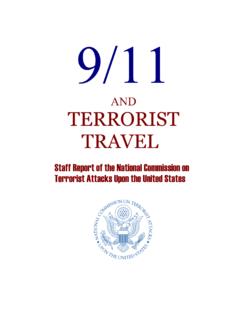Transcription of Staff Statement No. 16 - FINAL - 9-11commission.gov
1 1 Outline of the 9/11 Plot Staff Statement No. 16 Members of the Commission, your Staff is prepared to report its preliminary findings regarding the conspiracy that produced the September 11 terrorist attacks against the United States. We remain ready to revise our understanding of this subject as our work continues. Dietrich Snell, Rajesh De, Hyon Kim, Michael Jacobson, John Tamm, Marco Cordero, John Roth, Douglas Greenburg, and Serena Wille did most of the investigative work reflected in this Statement . We are fortunate to have had access to the fruits of a massive investigative effort by the Federal Bureau of Investigation and other law enforcement agencies, as well intelligence collection and analysis from the Central Intelligence Agency, the National Security Agency, the State Department, and the Department of Defense.
2 Much of the account in this Statement reflects assertions reportedly made by various 9/11 conspirators and captured al Qaeda members while under interrogation. We have sought to corroborate this material as much as possible. Some of this material has been inconsistent. We have had to make judgment calls based on the weight and credibility of the evidence. Our information on statements attributed to such individuals comes from written reporting; we have not had direct access to any of them. Plot Overview Origins of the 9/11 Attacks The idea for the September 11 attacks appears to have originated with a veteran jihadist named Khalid Sheikh Mohammed (KSM). A Kuwaiti from the Baluchistan region of Pakistan, KSM grew up in a religious family and claims to have joined the Muslim Brotherhood at the age of 16.
3 After attending college in the United States, he went to Afghanistan to participate in the anti-Soviet jihad. Following the war, he helped run a non-governmental organization in Pakistan assisting the Afghan mujahidin. KSM first came to the attention of authorities as a result of the terrorist activity of his nephew Ramzi Yousef, the mastermind of the 1993 World Trade Center bombing. KSM provided a small amount of funding for that attack. The following year, he joined Yousef in the Philippines to plan what would become known as the Bojinka operation, 2the intended bombing of 12 commercial jets over the Pacific in a two-day period. That plot unraveled, however, when the Philippine authorities discovered Yousef s bomb-making equipment in Manila in January 1995.
4 During the course of 1995, Yousef and two of his co-conspirators in the Bojinka plot were arrested overseas and were brought to the United States for trial, but KSM managed to elude capture following his January 1996 indictment for his role in the plot. By the middle of 1996, according to his account, KSM was back in Afghanistan. He had met Usama Bin Ladin there in the 1980s. Now, in mid-1996, KSM sought to renew that acquaintance, at a point when Bin Ladin had just moved to Afghanistan from the Sudan. At a meeting with Bin Ladin and Mohamed Atef, al Qaeda s Chief of Operations, KSM presented several ideas for attacks against the United States. One of the operations he pitched, according to KSM, was a scaled-up version of what would become the attacks of September 11.
5 Bin Ladin listened, but did not yet commit himself. Bin Ladin Approves the Plan According to KSM, the 1998 East Africa embassy bombings demonstrated to him that Bin Ladin was willing to attack the United States. In early 1999, Bin Ladin summoned KSM to Kandahar to tell him that his proposal to use aircraft as weapons now had al Qaeda s full support. KSM met again with Bin Ladin and Atef at Kandahar in the spring of 1999 to develop an initial list of targets. The list included the White House and the Pentagon, which Bin Ladin wanted; the Capitol; and the World Trade Center, a target favored by Ladin quickly provided KSM with four potential suicide operatives: Nawaf al Hazmi, Khalid al Mihdhar, Walid Muhammad Salih bin Attash, also known as Khallad, and Abu Bara al Taizi.
6 Hazmi and Mihdhar were both Saudi nationals although Mihdhar was actually of Yemeni origin and experienced mujahidin, having fought in Bosnia together. They were so eager to participate in attacks against the United States that they already held visas. Khallad and Abu Bara, being Yemeni nationals, would have trouble getting visas compared to Saudis. Therefore, KSM decided to split the operation into two parts. Hazmi and Mihdhar would go to the United States, and the Yemeni operatives would go to Southeast Asia to carry out a smaller version of the Bojinka the fall of 1999, training for the attacks began. Hazmi, Mihdhar, Khallad, and Abu Bara participated in an elite training course at the Mes Aynak camp in Afghanistan.
7 Afterward, KSM taught three of these operatives basic English words and phrases and showed them how to read a phone book, make travel reservations, use the Internet, and encode communications. They also used flight simulator computer games and analyzed airline schedules to figure out flights that would be in the air at the same time. 3 Kuala Lumpur Following the training, all four operatives for the operation traveled to Kuala Lumpur, Malaysia. Khallad and Abu Bara were directed to study airport security and conduct surveillance on carriers, and Hazmi and Mihdhar were to switch passports in Kuala Lumpur before going on to the United States. Khallad who traveled to Kuala Lumpur ahead of Hazmi and Mihdhar attended a prosthesis clinic in Kuala Lumpur.
8 He then flew to Hong Kong aboard a airliner and was able to carry a box cutter, concealed in his toiletries bag, onto the flight. He returned to Kuala Lumpur, where Hazmi and Mihdhar arrived during the first week in January 2000. The al Qaeda operatives were hosted in Kuala Lumpur by Jemaah Islamiah members Hambali and Yazid Sufaat, among others. When Khallad headed next to a meeting in Bangkok, Hazmi and Mihdhar decided to join him to enhance their cover as tourists. Khallad had his meetings in Bangkok and returned to Kandahar. Khallad and Abu Bara would not take part in a planes operation; in the spring of 2000, Bin Ladin cancelled the Southeast Asia part of the operation because it was too difficult to coordinate with the part.
9 Hazmi and Mihdhar spent a few days in Bangkok and then headed for Los Angeles, where they would become the first 9/11 operatives to enter the United States on January 15, 2000. Four Students in Hamburg While KSM was deploying his initial operatives for the 9/11 attacks to Kuala Lumpur, a group of four Western-educated men who would prove ideal for the attacks were making their way to the al Qaeda camps in Afghanistan. The four were Mohamed Atta, Marwan al Shehhi, Ziad Jarrah, and Ramzi Binalshibh. Atta, Shehhi, and Jarrah would become pilots for the 9/11 attacks, while Binalshibh would act as a key coordinator for the plot. Atta, the oldest of the group, was born in Egypt in 1968 and moved to Germany to study in 1992 after graduating from Cairo University.
10 Shehhi was from the United Arab Emirates (UAE) and entered Germany in 1996 through a UAE military scholarship program. Jarrah was from a wealthy family in Lebanon and went to Germany after high school to study at the University of Greifswald. Finally, Binalshibh, a Yemeni, arrived in Germany in 1995. Atta and Binalshibh were the first of the four to meet, at a mosque in Hamburg in 1995. In 1998, Atta and Binalshibh moved into a Hamburg apartment with Shehhi, who had been studying in Bonn; after several months, the trio moved to 54 Marienstrasse, also in Hamburg. How Shehhi came to know Atta and Binalshibh is not clear. It is also unknown just how and when Jarrah, who was living in Greifswald, first encountered the group, but we do know that he moved to Hamburg in late 1997.


